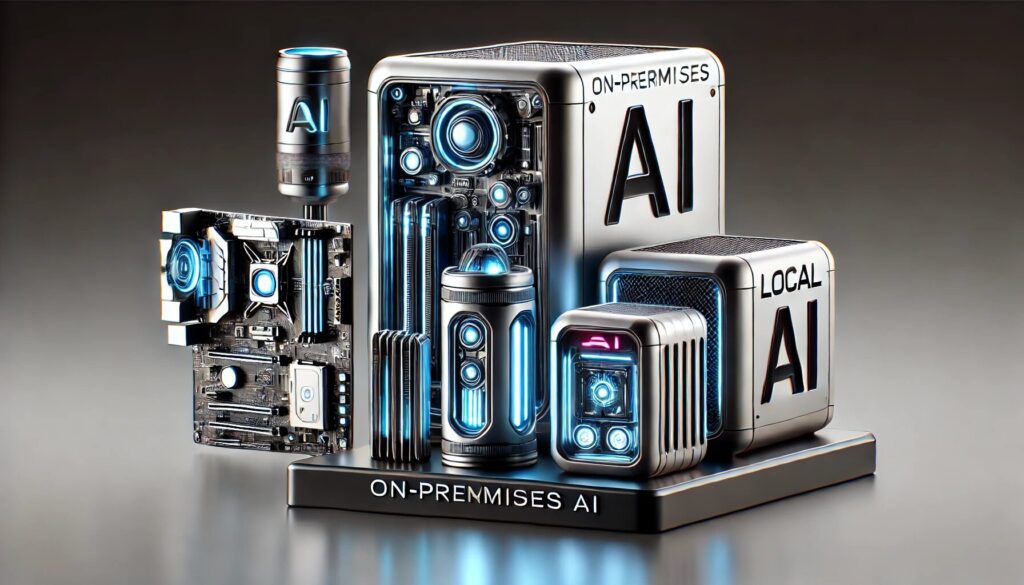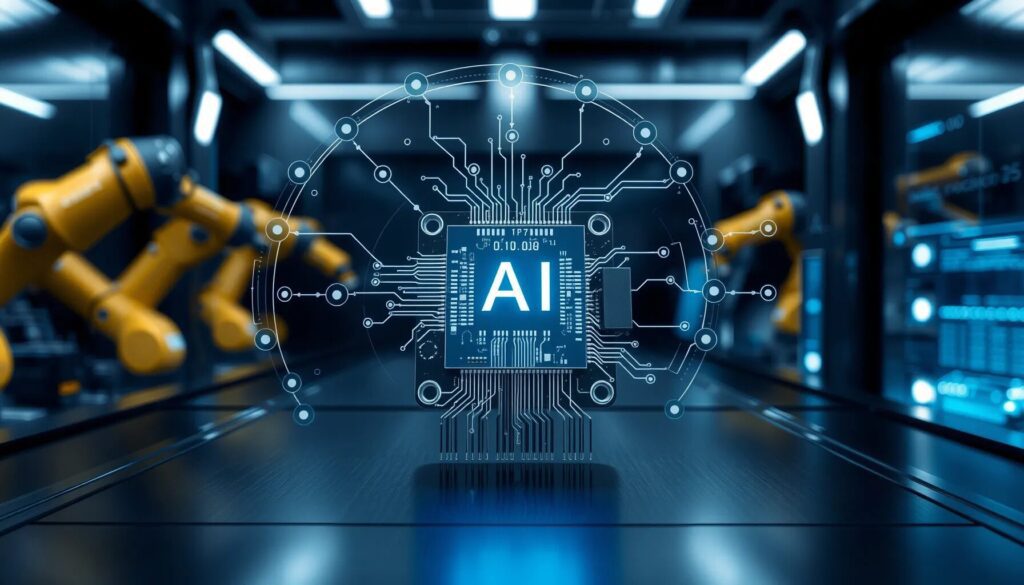
What Does It Mean to Run AI Without the Cloud?
Imagine having all the power of artificial intelligence at your fingertips, without relying on cloud servers or constant internet connections.
Running AI models directly on your computer means that instead of sending data to the cloud for processing, everything happens locally. Whether it’s for image recognition, speech analysis, or even generating text like this, it’s all happening on your machine!
This opens up a world of possibilities, from faster response times to improved privacy. But how does it really work, and why should you even consider it? Let’s dive in!
Why You Should Consider Local AI Tools
The idea of bringing AI models straight to your PC isn’t just for tech enthusiasts or large corporations. With advancements in hardware and software, anyone can benefit from running AI models locally. Here’s why:
- Privacy: No need to send sensitive data across the web.
- Speed: Local models can cut down on lag since everything is processed instantly on your device.
- Control: You get to fine-tune the model’s performance, adjust parameters, and decide how it works.
- Offline Access: Need AI for remote areas? It works without an internet connection.
You’re not at the mercy of cloud outages, and that independence is valuable.
Top Benefits of Running AI Locally
If you’ve ever used cloud-based AI services, you know how convenient they can be. But local AI tools offer distinct benefits that might just make you rethink your approach.
- Reduced Costs: Cloud computing fees can rack up quickly. Running AI on your machine saves on those expenses.
- Enhanced Security: Your data stays on your device, reducing the risk of breaches.
- Customization: Modify and tailor models specifically for your unique tasks or projects.
- Real-time Processing: With local AI, you avoid the latency associated with cloud processing.
- Environmentally Friendly: Reducing your cloud footprint can lower energy consumption.
System Requirements for Local AI Models

Before diving headfirst into local AI, you need to check if your system is ready for the task. Not every computer is equipped to handle AI processing, and it’s important to know what’s under the hood.
- CPU and GPU Power: AI models, especially those involving deep learning, require robust processors. Having a high-end GPU (Graphics Processing Unit) will greatly enhance the performance.
- Memory (RAM): Most AI models are memory-intensive. You’ll want at least 16GB of RAM for optimal performance.
- Storage: Large AI models need space. Depending on the size of the models you’re working with, having 500GB to 1TB of free disk space is ideal.
- Software Compatibility: Ensure your operating system supports the frameworks (TensorFlow, PyTorch, etc.) needed to run your models.
Popular Local AI Tools You Can Use Today
The great news? There’s a growing list of tools that make running AI models locally easier than ever. Here’s a breakdown of some of the most popular ones you can try out.
- TensorFlow Lite: Google’s open-source tool built for running lightweight AI models on edge devices.
- ONNX (Open Neural Network Exchange): Designed for running AI models across different platforms, ONNX offers great flexibility.
- PyTorch: A popular framework among researchers and developers, PyTorch can be run locally, making it a top choice for many AI tasks.
- Apple Core ML: Built specifically for macOS and iOS, this tool optimizes models to run efficiently on Apple devices.
- Intel OpenVINO: Tailored for computer vision tasks, OpenVINO allows you to accelerate inference on Intel hardware.
These tools bring AI directly to your machine, offering endless possibilities without ever needing a server!
How to Get Started with TensorFlow Lite
One of the simplest ways to dive into local AI is by using TensorFlow Lite. It’s designed to run lightweight AI models on your devices, including smartphones and PCs. Setting it up is straightforward:
- Install TensorFlow Lite using Python’s pip package manager.
- Download pre-trained models, or convert larger TensorFlow models into Lite versions.
- Integrate the model into your project using a few lines of code, and you’re ready to run AI tasks offline!
The beauty of TensorFlow Lite is how optimized it is for smaller devices, so even if you’re not on a powerhouse machine, you can still enjoy the benefits of AI at your fingertips.
Exploring ONNX: A Versatile AI Framework
ONNX (Open Neural Network Exchange) is a framework that’s all about flexibility. The key selling point is that it allows you to move AI models between platforms seamlessly. Let’s say you’ve trained a model in PyTorch but want to deploy it using TensorFlow – ONNX makes that possible!
To start with ONNX:
- Install the ONNX framework on your machine.
- Convert your AI models into the ONNX format.
- Use ONNX Runtime to execute the model on your device, no cloud needed!
ONNX supports a wide range of models and platforms, making it a perfect choice if you’re juggling between different tools.
Using PyTorch Locally: What You Need to Know
PyTorch has become a favorite among researchers and developers for its ease of use and flexibility. Running PyTorch models locally allows you to take full advantage of your computer’s hardware while maintaining control over your projects. Here’s how to get started:
- Install PyTorch on your system via the command line.
- Choose between CPU and GPU support, depending on your hardware setup.
- Load a pre-trained model or train your own on your machine.
- Execute tasks like natural language processing, image classification, or even complex deep learning projects – all locally!
PyTorch’s dynamic computational graph makes debugging easy, which is another reason why it’s so popular for local AI tasks.
The Role of Edge AI in Local Processing
Edge AI takes local processing a step further. Instead of sending data to remote servers, edge devices process AI tasks right where they are. This makes things faster, more efficient, and keeps everything contained in one place. Devices like smartphones, smart cameras, and even drones are now capable of edge AI tasks like object detection or speech recognition without relying on the cloud.
With edge AI, you can:
- Run AI in real-time with minimal latency.
- Make decisions locally, which is crucial for devices in remote or disconnected environments.
- Achieve power efficiency, since no data is sent to the cloud.
Edge AI is perfect for applications where speed and privacy are key, like autonomous driving or personalized healthcare devices.
Balancing Performance and Accuracy on Your Device

When running AI models on your computer, there’s often a trade-off between performance and accuracy. Large, complex models may give the most precise results, but they can slow down your machine. On the other hand, lightweight models are fast but might sacrifice some accuracy.
Here’s how to strike a balance:
- Model Pruning: Simplify your model by removing less important parameters without significantly affecting accuracy.
- Quantization: Convert your model from a high-precision format (like 32-bit) to a lower one (8-bit). This can reduce the size and speed up execution.
- Optimization Libraries: Use libraries like ONNX Runtime or TensorFlow’s optimization tools to speed things up without sacrificing much performance.
By fine-tuning these aspects, you’ll ensure your local AI models run efficiently without hogging all your computer’s resources.
Privacy Advantages of Running AI Without the Cloud
One of the biggest advantages of running AI models locally is the heightened level of privacy. In an age where data security concerns are constantly growing, keeping your data on your device can be a game-changer. Here’s why:
- No Data Sharing: When you run AI locally, your sensitive information—whether it’s personal photos, voice recordings, or confidential documents—never leaves your device.
- Reduced Exposure to Hacks: Cloud services are often targeted by cybercriminals. Local AI eliminates the risk of those external breaches.
- Full Control: You dictate how your data is stored, processed, and deleted, giving you peace of mind in terms of digital privacy.
So, whether you’re concerned about personal data privacy or working on proprietary projects, keeping everything local ensures you have control over your information.
The Challenges of Local AI Models and How to Overcome Them
While running AI models locally offers immense advantages, it doesn’t come without its challenges. But don’t worry, they’re manageable with the right approach:
- Hardware Limitations: Not every machine is equipped for intense AI processing. However, using optimized tools like TensorFlow Lite or pruning models can help run AI smoothly on less powerful hardware.
- Storage Issues: AI models can be large, and depending on the task, they might eat up a lot of space. Try compressing models or using external storage solutions to mitigate this problem.
- Complex Setup: The initial setup for local AI models might feel intimidating, especially for beginners. Fortunately, there are tons of tutorials, pre-trained models, and libraries like ONNX that can simplify the process.
- Maintenance: Local models need to be updated and tweaked as your projects evolve. Setting up a routine for updates will ensure your system stays cutting-edge.
With a little bit of preparation, you can sidestep these challenges and keep your local AI running smoothly.
AI at Your Fingertips: Voice Assistants and Image Recognition Offline
You’d be surprised at the AI tools you can run directly on your computer without cloud dependency. From voice assistants to image recognition, local AI can handle a variety of tasks without missing a beat:
- Voice Assistants: Tools like Mycroft allow you to have an intelligent voice assistant that doesn’t send any data to cloud servers. Imagine asking your assistant to set reminders or check your calendar, knowing your data never leaves your device.
- Image Recognition: Whether you’re working on facial recognition projects or object detection, models like OpenCV or TensorFlow Lite can easily process these tasks on your machine.
- Text Processing: Even tasks like natural language processing (NLP) can be handled locally, perfect for creating offline chatbots or text analysis tools.
The applications are endless, and running them without relying on the cloud gives you the flexibility and security that’s hard to beat.
Local AI in Gaming and Entertainment

Running AI models locally isn’t limited to business or personal productivity. It’s also making waves in gaming and entertainment industries. Ever wondered how your favorite games are using AI without a constant internet connection?
- AI in Gaming: Many games use local AI to control non-playable characters (NPCs), offer personalized experiences, and improve gameplay dynamics without relying on external servers.
- Entertainment Recommendations: Local AI can offer customized music playlists or movie suggestions based on your preferences, all without tracking your choices in the cloud.
- Augmented Reality (AR): Some AR experiences are powered by local AI to allow real-time adjustments without lag, creating seamless, immersive environments.
By using AI locally, game developers and content creators can deliver powerful experiences that feel immediate and responsive, enhancing user engagement without the need for a constant internet connection.
How to Keep Your Local AI Model Updated
While local AI models offer independence from the cloud, keeping them updated is key to ensuring they perform efficiently and accurately. Here’s a simple approach to maintaining your models:
- Scheduled Updates: Set reminders to periodically update your AI models with new data or optimizations. This could be monthly or quarterly, depending on your needs.
- Retraining: Regularly feed your AI new data to improve its accuracy. This step is crucial, especially for evolving tasks like voice recognition or language models.
- Monitoring: Keep an eye on your model’s performance. If you notice a decline in accuracy or speed, it might be time for an upgrade or fine-tuning.
Just because your AI runs locally doesn’t mean it should be left to stagnate. With the right upkeep, your models will remain sharp and ready for any task.
Future Trends: AI on Devices vs. AI in the Cloud
As technology evolves, the battle between local AI and cloud-based AI will continue to shape how we interact with smart devices. So, what does the future hold?
- Edge AI Growth: Expect more edge devices like smartphones, smart home gadgets, and IoT devices to come equipped with advanced AI capabilities that run entirely offline. This will be driven by the demand for real-time processing, privacy, and faster response times.
- Hybrid AI Models: In the near future, many systems will combine both local and cloud AI. For instance, your device might handle smaller tasks while complex computations are outsourced to the cloud.
- Advanced Local AI Chips: Companies like NVIDIA and Apple are already developing specialized chips to handle AI workloads locally. As these chips become more powerful and affordable, they’ll enable even more sophisticated tasks on everyday devices.
- Sustainability: Running AI locally reduces the environmental cost associated with massive cloud computing data centers. As society shifts toward greener tech, this could be a major factor in favor of local AI solutions.
As AI technology continues to advance, the choice between local and cloud will likely depend on your needs—speed and privacy versus vast computational power.
With this, we’ve explored the world of running AI models directly on your computer, covering the tools, benefits, challenges, and future trends. If you’re ready to unlock the power of AI without the cloud, now’s the time to dive in and see what your machine can really do!
Resources
If you’re interested in learning more about running AI models locally, here are some excellent resources to get you started:
- TensorFlow Lite – Official documentation for Google’s lightweight AI framework, ideal for mobile and edge devices.
- ONNX (Open Neural Network Exchange) – Comprehensive resources and tutorials for working with ONNX, making it easy to deploy models across various platforms.
- PyTorch – Learn how to set up and run PyTorch models locally, with extensive tutorials for both beginners and advanced users.
- Apple Core ML – Explore how to implement AI locally on Apple devices using Core ML.
- Intel OpenVINO – A toolkit for optimizing and deploying AI models locally, especially useful for computer vision tasks.
- Mycroft AI – Build your own offline voice assistant with this open-source project, focused on privacy and local processing.
- OpenCV – A widely-used open-source library for computer vision tasks, perfect for image recognition running locally.
- Hugging Face – Offers pre-trained models that can be easily downloaded and run locally, especially for natural language processing (NLP) tasks.
- Edge AI Resources – A resource hub for learning more about edge AI and how it’s revolutionizing local processing.
- GitHub – Search for repositories with open-source AI models and frameworks that you can implement and run on your machine.





